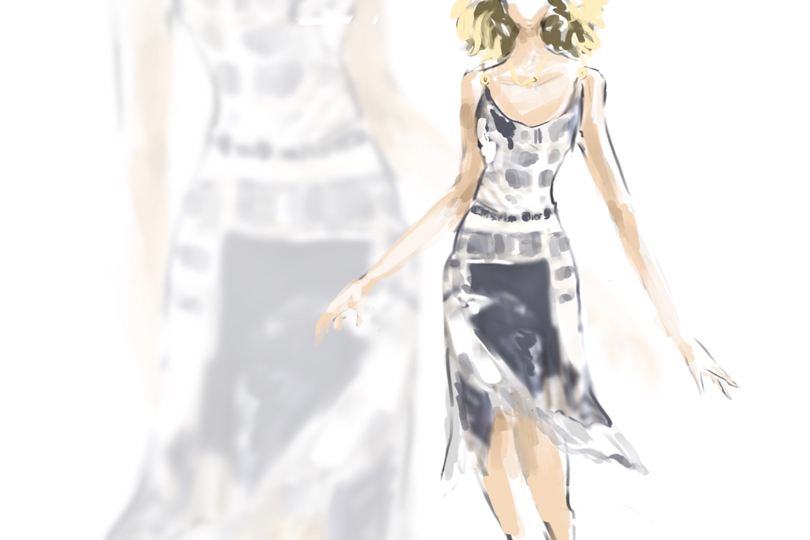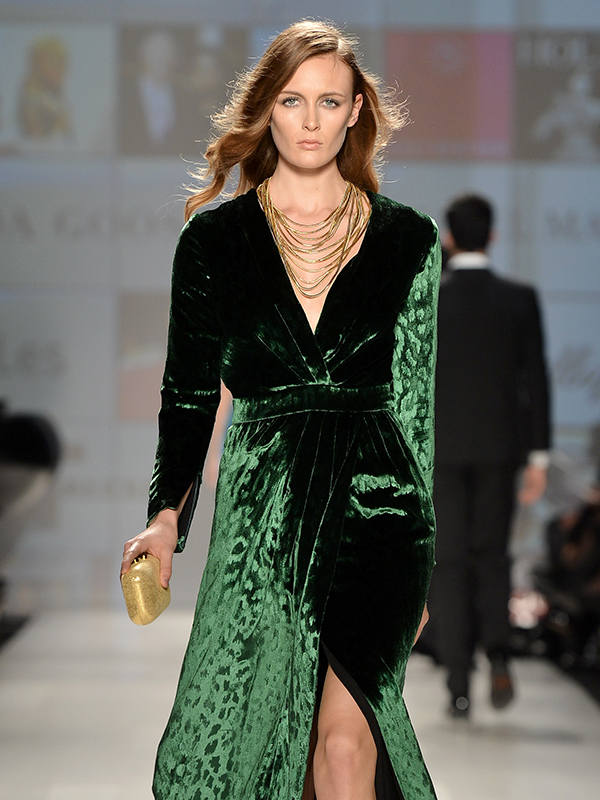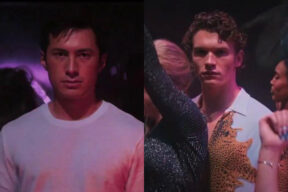Part of an ongoing series of 29Secrets stories, taking a deep dive into the history of legendary beauty products and iconic fashion and pop culture moments…
By Christopher Turner
Illustration by Michael Hak
There’s no doubt about it: Sex and the City had its fair share of iconic fashion moments throughout the years. With six seasons of the original HBO flagship series, plus two movies, the prequel series The Carrie Diaries on The CW and the most recent sequel series And Just Like That… for HBO Max, the title spans more than two decades’ worth of fashions that have inspired trends, put designers like Jimmy Choo and Manolo Blahnik on the map, and captivated audiences ever since the show’s debut in 1998. Of course, the main character Carrie Bradshaw (played by Sarah Jessica Parker) and her glamorous wardrobe and unforgettable closet led the way with arguably the most fashionable impact on viewers. And for good reason. Carrie, after all, was often heard uttering statements like, “I like my money right where I can see it. Hanging in my closet.”
One of Carrie’s most memorable fashion moments was when she stepped out wearing the slinky bias-cut John Galliano for Christian Dior newsprint dress back in Season 3 of the original series. That fashion moment was so big, the dress was brought back for a second outing 10 years later, a testament to its enduring appeal.
Fans may love it, but the dress actually has a pretty complicated history. Read on for the story behind Carrie’s oh-so-memorable Christian Dior newspaper dress.
“Hobo Chic”
British designer John Galliano initially designed the newspaper print for a Christian Dior collection that debuted in early 2000. Galliano, the then-creative director of the French fashion house, created the print as part of the “Hobo Chic” spring haute couture collection that was presented on January 17, 2000, at Versailles, about 19 kilometres west of Paris. The collection was partially inspired by Paris’s homeless population, specifically the hobos that Galliano claimed to observe while jogging along the Seine. Yes, homeless people. But the collection wasn’t initially seen as offensive, at least according to WWD’s original review of the runway presentation: “It wasn’t offensive, perhaps because he shows such great affection and respect for his subjects, and even falls in love with them a little.”
The “Hobo Chic” spring 2000 haute couture collection debuted a wide range of luxury pieces, including some that looked like newspapers had been piled on for warmth. Those runway pieces were accessorized with jewellery that was essentially strung compilations of assorted garbage, everything from dented kitchen utensils to mini whiskey bottles.
“John Galliano has more guts than the local butcher,” WWD’s review of the show began. “The collection was a startling display of talent, bravado and confidence.”
Of course, shortly after the debut of the couture collection, the headlines changed. Whether Galliano was upending ideas of class and privilege, or making fun of the dispossessed, was part of the debate. In France, appalled reaction started popping up from fashion critics and social welfare advocates alike. The French homeless community staged a protest in front of Dior’s headquarters in Paris bearing signs that read, “Cynicism isn’t cool!” and chanting, “Respect the homeless.” In the US, the New York Times critic Maureen Dowd likened the show to then-New York Mayor Rudolph Giuliani’s street sweep of the homeless. Dowd noted of the show at the time: “[The models] came down the runway raggedy and baggy, some swathed in newspapers, with torn linings and inside-out labels, accessorized with empty little green J&B whiskey bottles, tin cups dangling from the derriere, bottle caps, plastic clothespins and safety pins. Some posed as lunatic ballerinas in frayed tulle, others in straitjackets and white madhouse makeup.”
At first, Galliano called his critics “bourgeois people, condescending and smug.” As the controversy continued, however, he took a softer approach, offering in a statement, “I never wanted to make a spectacle of misery.”
The controversial fashion show even crossed over into pop culture the following year and was parodied and mocked when it inspired Derek Zoolander’s main nemesis, Mugatu’s unforgettable “Derelicte” collection in the 2001 film Zoolander, starring Ben Stiller and Will Ferrell. In the film, bad guy Mugatu (played by Ferrell) creates a collection for his New York Fashion Week show that he describes as “a fashion, a way of life inspired by the very homeless, the vagrants, the crack whores that make this wonderful city so unique.”
But, back to early 2000 and Galliano’s couture collection for Dior.
There were other inspirations for the “Hobo Chic” collection besides the street people the English couturier saw in the streets during his daily jog, including the aristocratic tramp balls of the 1920s; Galliano’s own 1984 graduation show at Central Saint Martins inspired by the French Revolution, entitled Les Incroyables; and…a newsprint pattern.
The idea for the “Christian Dior Daily” print that Galliano had created and was seen on the Versailles runway had been inspired (or lifted) by a newspaper print pattern that was designed by couturier Elsa Schiaparelli back in 1935, well before Galliano was even born.
Schiaparelli took press clippings written about her and transformed them into printed blouses and accessories. The designer noted in her autobiography that this idea came about after being inspired when travelling to Denmark on holiday, where she saw fishwives in Copenhagen wearing hats made of newspaper.
But Schiaparelli was not actually the first to find style inspiration in newspaper print. A newspaper-printed gown that was worn by Matilda Butters (the wife of an Australian politician) can be dated back to 1886, and Louis Réard, the inventor of the bikini, made headlines across the globe when he unveiled the two-piece bathing suit, which was covered in a newspaper print.
While the furor over Galliano’s “Hobo Chic” couture collection began dying down, he was already reworking the newsprint theme into his next ready-to-wear show for Christian Dior. When his fall/winter 2000 collection for Christian Dior was presented in Paris on February 28, 2000, The Christian Dior Daily (a newspaper created just for the show) was printed on chiffon, leather and even the reverse side of furs seen on the runway. The slinky bias-cut newspaper dress with gold link straps that would be made famous by SATC also made its runway debut that day as part of the collection. It was first worn by model Angie Schmidt.
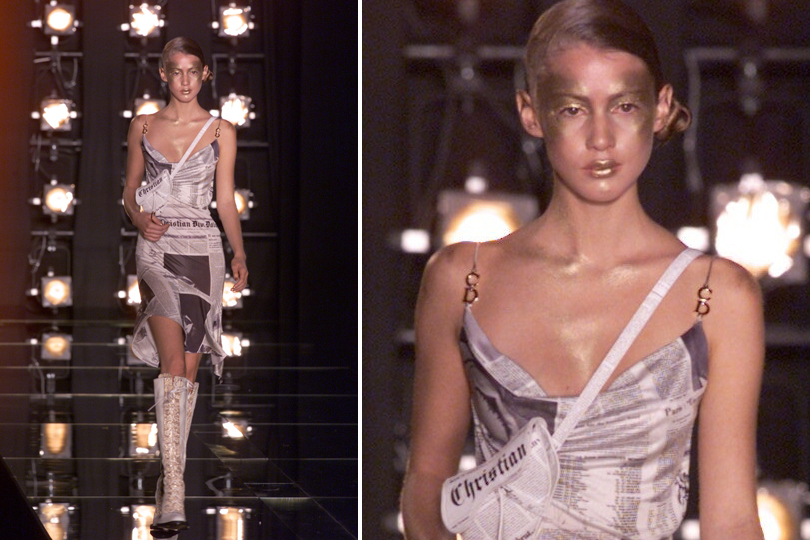
“What goes around comes around”
Its origins may be less than savoury, but this dress is a key part of Sex and the City history. Christian Dior’s fall/winter 2000 newspaper print dress is one of the dresses that has become synonymous with Sex and the City and Carrie Bradshaw. In fact, few outfits stand out more than that figure-flattering newspaper dress. Selected by SATC costume designer Patricia Field, the dress was styled with big hair, a pair of Manolo Blahnik heels, a Fendi baguette and the equally iconic namesake necklace that Carrie wore through the series. It was a fashion moment.
Carrie wore the dress in Season 3 of the original series: episode 17, “What Goes Around Comes Around” for those who want to re-watch the moment (the episode initially aired on October 8, 2000). HBO’s synopsis reads: “Upset by a hateful glance from Natasha who saw the quartet in a restaurant, Carrie loses her way and gets robbed of not just valuables but, far worse, her favourite designer sandals.”
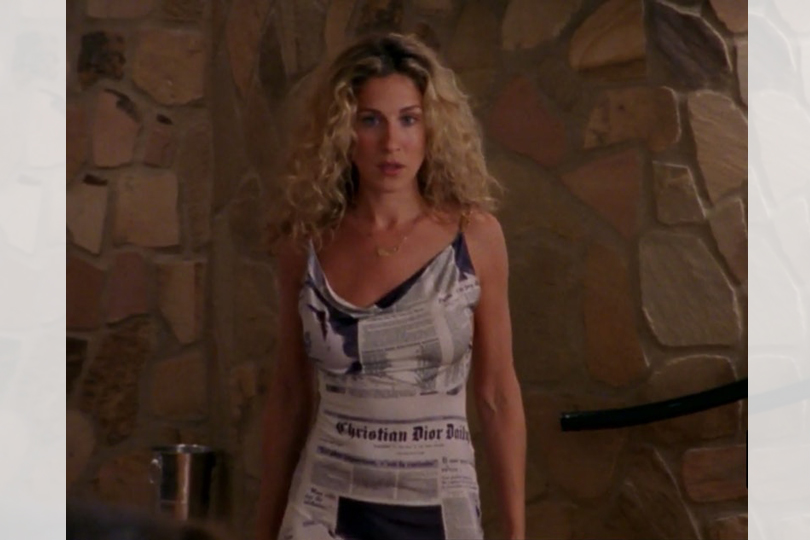
For those looking for a more direct refresher, Carrie wore the Christian Dior newspaper dress towards the end of the episode when she ambushes Natasha in a restaurant and asks for forgiveness after sleeping with Natasha’s then-husband Mr. Big. It was uncomfortable to say the least, and one of Carrie’s most memorable love her/hate her moments. After Natasha’s epic slap back – “Now not only have you ruined my marriage, you’ve ruined my lunch” – Carrie leaves the restaurant and closes the episode strutting, in slow motion, through the traffic-filled streets of Manhattan wearing the dress.
Field’s understanding of fashion and her desire to have the clothes and shoes have deeper meaning was obvious in countless sartorial choices for the series. This moment was no different. What Carrie had done was scandalous, and the décolletage-baring dress, which Carrie wore in the closing scenes of the episode, encapsulated that.
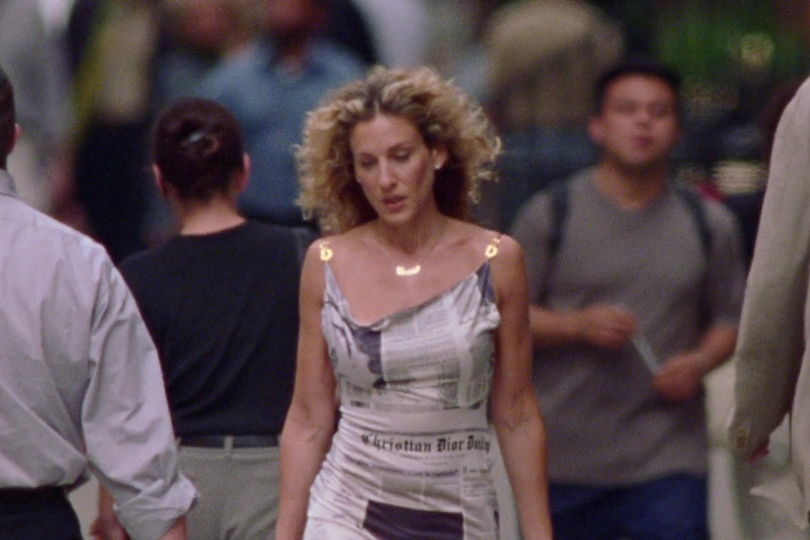
The moment and the look stayed with viewers. In fact, the look was so legendary that the slinky silk dress ended up making a second appearance in the arguably less iconic 2010 film Sex and the City 2. In the film, Carrie slips on the familiar newspaper dress, almost in rebellion, before heading out to meet the girls.
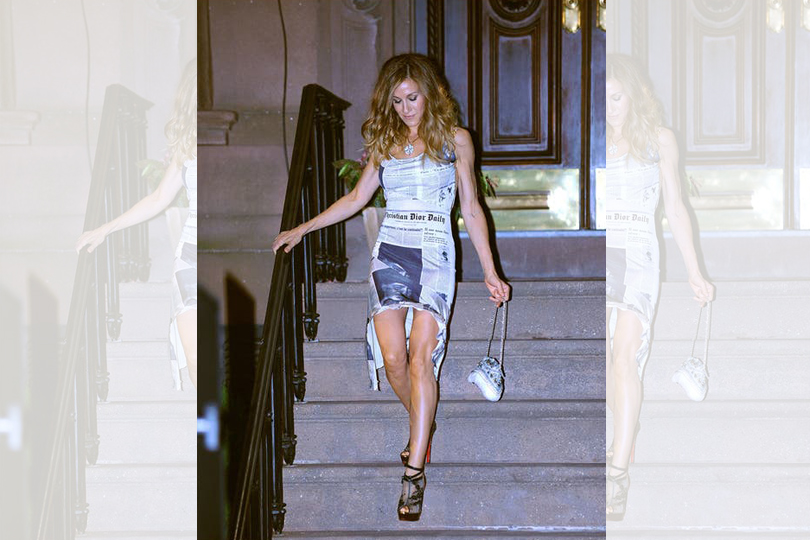
Legacy
Of course, the Sex and the City connection has ensured that the John Galliano for Christian Dior newsprint dress has a permanent place in fashion and pop culture history. Despite the controversial origins of the dress and the print, and the fact that it’s been decades since it first appeared on our screens, we’re still obsessed with it. The print has seen a renaissance on the catwalk over the past few seasons with Balenciaga, Calvin Klein, Helmut Lang, Diane von Fürstenberg and Versace all debuting their own versions of the iconic newspaper print dress. More accessible mass retailers like Réalisation Par, Shein and (earlier this year) Zara have knocked off the print and released their own versions of the Carrie-esque statement dress. Last year, American clothing brand Reformation released its reinterpretation of the dress, but, unlike other brands, it decided to take a more conscious approach to the subject by printing headlines like “Hell Freezes” and “World Peace Achieved,” in addition to using recycled fabrics and ecological materials and reusing leftovers created during the manufacturing process.
The real question is, would Carrie approve of the never-ending knockoffs?
![]()
Want more? You can read other stories, including the story of the tutu in the opening credits of Sex and the City from our The Story Of series right here.

